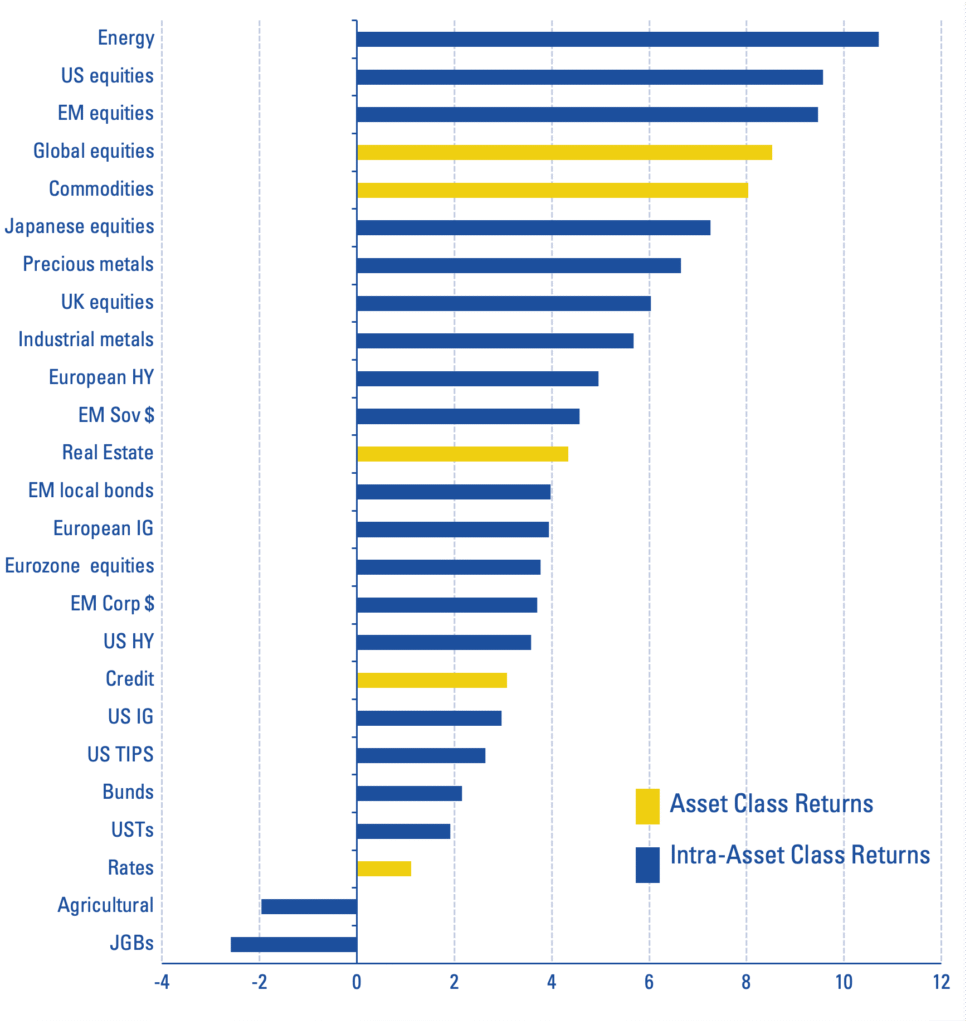Cross-Asset Quarterly Outlook
September 2025*
Upgrading Equities
- We expect global equities to outperform fixed income, supported by fading tariff risks, easier monetary policy, and AI investment.
- Short-term headwinds remain, but a more supportive monetary backdrop should limit pullbacks and support risk assets.
- We upgrade equities to overweight, funded by reduced rate exposure (via a downgrade to JGBs). Within rates, we also reduce our US TIPS overweight and upgrade EM local bonds to neutral. We remain overweight precious and industrial metals and underweight high-yield credit.
Global equities were the strongest-performing asset class over the past three months (see chart 1) and have managed to recover from several shocks, including a sharp rise in US tariffs, a military conflict in the Middle East, and rising bond term premia. Some risks remain for global markets, and recent US labour market data indicate weakening job growth. However, if the US avoids a recession this year and the Fed cuts rates (our base case), equities have historically outperformed.
In our last Cross-Asset Quarterly, we outlined the crosscurrents that kept our equity stance as neutral, while emphasizing our conviction in trades benefiting from US dollar weakness. The latter view remains intact, and we continue to expect cyclical and structural forces to weigh on the dollar, favouring non-US equities and precious metals. Further details can be found in our July 2025 report USD Weakness: A Crowded Idea, Uncrowded Trade. For equities versus fixed income, our view has shifted in favour of equities. As tariff risks fade, monetary policy eases, and AI investment continues to drive growth, stocks will likely trend higher. We describe our new baseline scenario as ‘quasi-Goldilocks’.
‘Goldilocks’ is typically defined as steady economic growth that is neither too hot nor too cold – i.e., a recession is avoided and inflation remains stable. Stocks can perform well in this environment as financial conditions ease and earnings grow. US growth slowed in 1H25 and will likely remain below trend in the second half of the year as tariffs, immigration restrictions, and slowing consumption weigh on activity. Still, AI-related investment and potential positive impacts from deregulation and the One Big Beautiful Bill (OBBB) provide some offset. Also, the upcoming 2026 US midterms will further incentivise the Trump administration to tailor policies to support the economy and avoid a recession. We use the term ‘quasi-Goldilocks’ because inflation is elevated and expected to rise in response to tariffs, but the ‘consumption tax’ should eventually have a deflationary effect after the initial price shock. A growing number of FOMC members share this view, potentially shifting the majority to prioritise the Fed’s maximum employment mandate at the upcoming meetings.
The market narrative is likely to centre around the Fed and other global central banks. At the current 4.50% policy rate, the Fed has room to react to weaker data. Furthermore, approximately $7 trillion is parked in money market funds earning roughly 4%, which could be reallocated to duration, equities, or other assets (e.g., hard assets or alternatives) as short-term rates decline. Additionally, many non-US central banks are either cutting or expected to cut rates this year (see chart 2). Overall, the global monetary backdrop is becoming more supportive for financial assets.
Chart 1: Jun-Aug Performance (%)

Source: Bloomberg
*The publication reflects asset performance up to August 29, 2025, and macro events and data releases up to September 5, 2025, unless indicated otherwise.
The information contained herein is obtained from sources believed by City of London Investment Management Company Limited to be accurate and reliable. No responsibility can be accepted under any circumstances for errors of fact or omission. Any forward looking statements or forecasts are based on assumptions and actual results may vary from any such statements or forecasts.